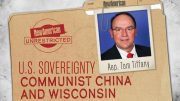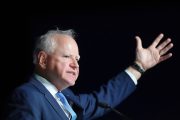During the fourth Republican presidential debate hosted by Fox Business and the Wall Street Journal, Donald Trump received flak for his response to a question about the Trans-Pacific Partnership (TPP) when Senator Rand Paul pointed out China was not part of the TPP agreement.
Moderator Gerald Baker, the editor-in-chief of the Wall Street Journal, asked Trump about his opposition to the TPP:
Mr. Trump, let’s talk about the international economy…. The U.S. just concluded an international trade agreement with 11 countries in the Pacific. You’ve said that you’d rather have no deal than sign the one that’s on the table. Most economists say that trade has boosted growth, and every single post war president has supported the expansion of international trade, including the last three republican presidents. Why would you reverse more than 50 years of U.S. trade policy?
In part, Trump answered:
The TPP is a horrible deal. It is a deal that is going to lead to nothing but trouble. It’s a deal that was designed for China to come in, as they always do, through the back door and totally take advantage of everyone. It’s 5,600 pages long. So complex that nobody’s read it. It’s like Obamacare; nobody ever read it. They passed it; nobody read it. And look at mess we have right now. And it will be repealed. [Emphasis added.]
… So I must say, Gerard, I just think it’s a terrible deal. I love trade. I’m a free trader, 100 percent. But we need smart people making the deals, and we don’t have smart people making the deals.
Baker continued with a follow-up question, asking Trump what specific part of the TPP agreement he thought was “badly negotiated.” Baker asked,
The deal, as you say, the terms of the deal were published — were published just last week, the details, 5,000 pages of it, and 80 percent of U.S. trade with countries in the Pacific, these countries, these 11 countries, is actually tariff-free, and these — the trade deal only affects the other 20 percent. Which — are there particular parts of the deal that you think were badly negotiated?
Trump, in response, brought up the lack of currency manipulation discussed in the agreement:
Yes. Well, the currency manipulation they don’t discuss in the agreement, which is a disaster. If you look at the way China and India and almost everybody takes advantage of the United States — China in particular, because they’re so good. It’s the number-one abuser of this country. And if you look at the way they take advantage, it’s through currency manipulation. It’s not even discussed in the almost 6,000-page agreement. It’s not even discussed.
Rand Paul, from the right of the stage, interjected: “Hey, Gerard, you know, we might want to point out China is not part of this deal.”
Paul’s remarks resulted in laughter and applause from the audience, with two of the moderators agreeing with him. However, when examining the facts about the TPP in comparison to what Trump actually said, Paul’s attempt to embarrass Trump falls flat.
Although Paul is technically correct that China is not part of the TPP, Trump never said that it was. What Trump actually said about the TPP and China was, “It’s a deal that was designed for China to come in, as they always do, through the back door.” And Trump is exactly correct.
As The New American has previously reported numerous times over the past few years (see here, here, here, and here), the TPP was in fact designed for China to eventually be brought into the agreement.
On August 23, 2013, in “Regional Scheme for the Pacific Rim,” The New American reported:
The TPP, which currently involves 12 nations — Australia, Brunei, Canada, Chile, Malaysia, Mexico, New Zealand, Peru, Singapore, the United States, and Vietnam (Japan is negotiating for membership and is likely to join soon) — is really intended as an interim arrangement, on the road to an expanded Free Trade Area of the Asia Pacific (FTAAP) that would include all 21 nations of the grouping known as the Asia-Pacific Economic Cooperation (APEC). That includes China and Russia. [Emphasis added.]
In the print version of “Trans-Pacific Partnership to Facilitate U.S.-China Merger,” published in the February 2, 2015 issue of The New American magazine (as opposed to the earlier December 2014 online version of the article with the same title), we reported:
Here is the deception: TPP proponents know that a large American constituency is already very alarmed over the outsourcing of jobs and industry to China and the huge inroads that China is making into the American economy. So TPP advocates are telling this concerned audience that the TPP — which, at present, does not include China — will give American workers and companies a big new advantage against competition from China. However, these same TPP proponents are duplicitously telling other audiences that China will probably be admitted into the TPP and that, at any rate, the final game plan is to have the TPP subsumed into the larger planned Free Trade Area of the Asia Pacific (FTAAP), which will include not only Communist China, but Russia as well.
As The New American has reported, China’s eventual inclusion into the TPP is part of developing a broader regional trade scheme under APEC, known as the FTAAP. Both China and the United States are leading APEC members.
On November 11, 2014, during the 2014 APEC summit, held in Beijing, APEC leaders, including Chinese President Xi Jinping and U.S. President Barack Obama, put forward their joint “2014 Leaders’ Declaration,” with the subtitle, “The 22nd APEC Economic Leaders’ Declaration — Beijing Agenda for an Integrated, Innovative and Interconnected Asia-Pacific.” Under Article I, revealingly entitled “Advancing Regional Economic Integration Pursuing Free and Open Trade and Investment,” section 11 of the declaration reaffirmed APEC’s long-term goal of developing the FTAAP:
11. Recognizing APEC has a critical role to play in shaping and nurturing regional economic integration, we agree that APEC should make more important and meaningful contributions as an incubator to translate the Free Trade Area of the Asia-Pacific (FTAAP) from a vision to reality. We reaffirm our commitment to the eventual FTAAP as a major instrument to further APEC’s regional economic integration agenda.
The simple fact that President Obama agreed to this, as an APEC leader, demonstrates the United States’ intention to pursue further economic integration beyond the TPP to the entire Asia-Pacific rim under the proposed FTAAP agreement, which includes China. As for the TPP specifically, President Obama admitted that it is not designed or intended to contain China as suggested by the much of the mainstream media, including the Wall Street Journal. On December 11, 2014, President Obama said:
And by the way, there’s been some suggestion that by doing TPP we’re trying to contain or disadvantage China. We’re actually not. What we are trying to do is make sure that rather than a race to the bottom in the region there’s a reasonable bar within which we can operate. And we hope that then China actually joins us in not necessarily formally being a member of TPP but in adopting some of the best practices that ensure fairness in operations. [Emphasis added.]
Furthermore President Obama has never stated that China is barred from joining the TPP. In fact, the opposite is true. In a televised interview with Russian interstate channel Мир 24 ТВ (Mir TV), Secretary Kerry “invited China and Russia to join the Trans-Pacific Partnership (TPP),” The New American reported on November 4.
Shortly afterward, Breitbart News said that it was told by the State Department, “there are no talks with other countries on joining the TPP at this time.” However, as The New American’s William F. Jasper recently reported, “The not ‘at this time’ qualification does not contradict Kerry’s statement; it simply means not now.” Jasper added, “Of course, the [Obama] administration would not want to pursue TPP membership for Russia and China ‘at this time,’ since many pro-TPP congressmen view TPP as a counter-balance to China in the Trans-Pacific region. But as Kerry’s statement makes clear, the administration is looking down the road to TPP expansion.”
Further evidence validating Trump’s claim that TPP deal was “designed for China to come in, as they always do, through the back door,” as he said during the Fox Business Republican debate, is found in a pro-TPP book published in 2013 by the Peter G. Peterson Institute for International Economics (PIIE), entitled Understanding the Trans-Pacific Partnership. As The New American previously reported, “The PIIE is one of the premier global think tanks and has played an especially important role in promoting the WTO, IMF, United Nations, and free trade agreements (FTAs), including NAFTA, CAFTA, TPP, and FTAAP.”
On page 3 of Understanding the Trans-Pacific Partnership, the authors reveal the TPP’s true long-term objectives:
The TPP is regarded as an interim arrangement or stepping stone toward a broader, regionwide Free Trade Area of the Asia Pacific (FTAAP), possibly within a decade, as envisaged by APEC leaders in Bogor in November 1994 and reaffirmed more recently by them in their meeting in Honolulu in November 2011. TPP negotiators are not only thinking about new countries joining the ongoing talks but also planning and constructing the trade pact with a view toward future linkages with other APEC members, including and especially China. [Emphasis added.]
On page 51, in the book’s sixth chapter, entitled “Moving from TPP to FTAAP,” it further says:
The current TPP architects envision building an eventual FTAAP on the comprehensive foundations of the TPP accord, with other APEC countries joining the pact in coming years through an accession process similar to that provided in the WTO for new members. [Emphasis added.]
The book also describes how the FTAAP would serve as an umbrella agreement for both the TPP and the RCEP. The RCEP, or Regional Comprehensive Economic Partnership, is another proposed regional “free trade” agreement between 16 countries: the 10 member states of ASEAN, the Association of Southeast Asian Nations (Indonesia, Malaysia, Philippines, Singapore, Thailand, Brunei, Vietnam, Laos, Burma, and Cambodia); plus the three additional member states of ASEAN Plus Three (China, Japan, and South Korea); and Australia, New Zealand, and India. On page 63 it says:
[The] FTAAP — would be an umbrella providing reciprocal obligations applying to all TPP and RCEP countries while the more comprehensive and legally binding TPP provisions would remain in force among the TPP signatories. Importantly, the United States and China would deepen their commercial relationship without the strain of trying to fit China into the TPP or the cost diluting the TPP to accommodate China. [Emphasis added.]
Understanding the Trans-Pacific Partnership concludes reaffirming the TPP’s economic objectives for the Asia Pacific region:
To conclude, in trade negotiations, good things come in big packages. A big TPP deal would yield substantial commercial benefits, a strong foundation for Asia-Pacific economic integration, and important precedents and impetus for renewed multilateral trade talks. [Emphasis added.]
China may not be a member of the TPP at this time, but the designers of the TPP do intend to bring it in at a later date. That much is certain. Secretary John Kerry’s invitation for China and Russia to join the TPP is only the latest indicator pointing toward that long-term objective.
As for Trump’s additional objection about the TPP not mentioning currency manipulation, he is again correct. Several hours before the debate began in Milwaukee, Wisconsin, Senator Jeff Sessions (R-Ala.) went to the floor of the U.S. Senate where he spoke for approximately 12 minutes about the TPP, including its exclusion of currency manipulation from the text. Standing next to a voluminous printed stack of all 5,554-pages of the TPP agreement, Senator Sessions said:
Second, currency manipulation is a serious issue. It is impacting our ability to trade effectively today in a very large way.
… If you read the financial pages, you will see that companies are worried about their bottom line in large part because it will be harder for them to compete with foreign competitors who devalue their currency deliberately in order to gain an advantage in trade. But there is no enforceable currency mechanism in this agreement, although it was fought for in both Houses of Congress and came close, but it is not in it.
Senator Sessions further elaborated about the TPP’s omission of currency manipulation from the final agreement and the subsequent response it generated from Ford Motor Company; Sessions said:
The Wall Street Journal, on November 5, wrote: “Mexico, Canada and other countries signaled they were open to the [currency] deal when they realized it wouldn’t include binding currency rules that could lead to trade sanctions through the TPP.” This caused Ford Motor Company to immediately reject the TPP the day it was released. Their spokesman argued that they could not support a deal in which currency rules “fell outside of TPP and [failed to] include dispute settlement mechanisms to ensure global rules prohibiting currency manipulation are enforced.”
This is a huge matter. Ford says that when they are selling an American-made automobile or truck in a foreign country, they are losing thousands of dollars as a result of currency manipulation by many of our trading partners. So it is hard to sell an automobile if our foreign competitors have, in effect, a comparative advantage on currency alone of several thousand dollars.
Sessions added in his Senate remarks, “The administration has zero interest in preventing foreign market manipulations and currency manipulations, and thus the TPP will cause massive job losses. It just will. We will be less able to compete,” Unfortunately for Ford Motor Company and other U.S. manufactures and small business affected by currency manipulation, enforcement against it is not part of the TPP agreement as both Sessions and Trump accurately pointed out.
Senator Rand Paul’s attempt to portray Trump as being uninformed about the TPP, a narrative which was quickly embraced by the mainstream and liberal press, ultimately revealed Paul’s lack of insight, not Trump’s. It would behoove legislators such as Paul and others in the Senate, as well as in the House, to read and examine the bill before voting on it.
Related articles:
China Bids for Sheraton/Westin Hotels; TPP Will Help Beijing Buyouts
Senator Blasts TPP as “Global Governance,” Says Stop Fast-Track
Secret TPP Text Released: GOP to Push Obama’s Dangerous Trade Deal
Secretary John Kerry Invites Russia and China into TPP
Russia’s Backdoor Participation in the Trans-Pacific Partnership (TPP)
China Seeks to Join Trans-Pacific Partnership (TPP)
Globalists Now Pushing To Bring China Into TPP
Chinese Diplomat: TPP, FTAAP “Compatible; Complement Each Other”
Trans-Pacific Partnership To Facilitate U.S.-China Merger
Rand Paul to Obama: “Prioritize” Passage of Trans-Pacific Partnership
Obama Considering Chinese Participation in Trans-Pacific Partnership





